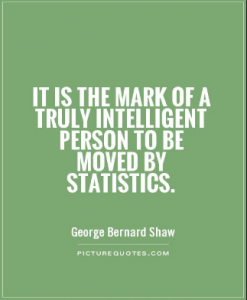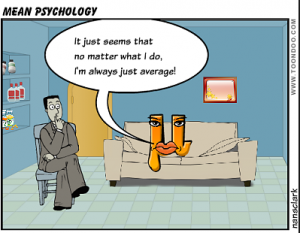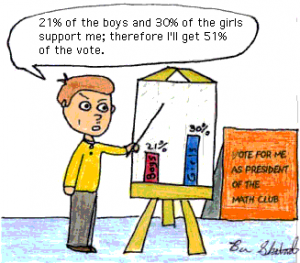Data Displays and Measurements
Standards:
- CCSS.MATH.CONTENT.HSS.ID.A.1
- CCSS.MATH.CONTENT.HSS.ID.A.2
- CCSS.MATH.CONTENT.HSS.ID.B.5
- CCSS.MATH.CONTENT.HSS.IC.A.1
- CCSS.MATH.CONTENT.HSS.IC.B.3
- CCSS.MATH.CONTENT.HSS.IC.B.4
- CCSS.MATH.CONTENT.HSS.IC.B.6
Data Representations Lesson 1 (Algebra 1)
Unit Title: Data Representations – Can Data Displays Impact Understanding?
Lesson Time Frame: 3 Class Periods
Lesson Opening (communicate to students at lesson onset): Data displays are used everyday in the media! We may not realize how often we see data displays used every day. Data displays are used by news outlets, advertisements and marketing, and social media to represent sample data and inform or sway audience members.
In this lesson, we will be analyzing various data displays and what conclusions we can make from the analysis. We will also be finding new data displays from media sources and try to draw conclusions based on analysis. Understanding how data displays can influence an audience is important for becoming critical thinkers in the real-world. At the end of the lesson, students will be able to break apart data displays, identify patterns and trends, draw conclusions, and make predictions about an entire population.

Learning Targets: What students will Understand (Generalizations), Know (Factual Content), and Be able to Do (Skills):
Generalization(s)
Students will understand that…
- There are various types of data displays and ways to represent data. Guiding Questions:
- What type of data displays exist? (F)
- What characteristics of a data set can influence the chosen data display? (C)
- How do media and marketing outlets use different data displays to influence populations? (D)
- Why are different types of data displays created? (C)
2. Varying data displays can be analyzed using statistical understanding . Guiding Questions:
- What measures of statistics can we use to help analyze data/data displays? (F)
- How do we compute and calculate measures of statistics from given data sets/displays? (F)
- Can all statistical measures be found for any given data display?/How can we determine which measures can be found given any data display? (C)
- What story can data displays and measures help to tell about samples or populations? (D)
- How can we use data displays and statistical measures to draw conclusions about data sets? (C)
- How can we make predictions about a population given any data display? (D)
- To what extent should we (as citizens) analyze data displays that are presented in the news and other media outlets. (D)
Note: the guiding questions above are sorted into:
- Factual (F)
- Conceptual (C)
- Debatable (D)
Components of CONCEPT-BASED CURRICULUM AND INSTRUCTION that play out in this lesson:
This lesson gives students the opportunity to analyze and interpret data displays and make connections to data displays used by media outlets.
There are facts that students are asked to know: Types of data displays and data measures, and formulas for the data measurements (mean, median, mode, range, etc.)
There are concepts that students are asked to understand: Various characteristics of a data set can lend themselves to given data displays and representations, and data displays may be chosen to influence and sway audience members.
There are skills that students are asked to be able to do: Analyze and interpret data displays, draw conclusions based on data displays, and make predictions about a population based on a data display from a sample of that population.
| Strand | Critical Content (Know) | Key Skills (Able to Do) |
| Data Displays |
|
|
| Statistical Measurements |
|
|
| Learning Experiences | Differentiations |
| Review the importance of statistics: Watch youtube videos that emphasizes the importance of understanding data and data displays.
|
Discussion on the videos supplemented by worksheets for student reflection. |
| Practice identifying types of data displays and what types of statistical measurements we can calculate. Discuss what the data displays predict about an entire population, and the types of bias that can be lurking in data displays and measurements.
To help students better understand biased data displays they can watch this video: https://www.youtube.com/watch?v=ETbc8GIhfHo |
Worksheets with different levels of scaffolding. |
| Students work in small groups to analyze data displays from media and news outlets (each group will have a different type of display) and present their findings to the class. | Mixed ability grouping. |
| Students find find other data representations and determine if they are bias or misleading and share their results with the class. | Provide resources to students. Allow for individual brainstorming and collaboration with peers. Teacher guidance throughout process. |
Materials/Resources:
Youtube Videos (posted below and linked above within lesson plan)
Student Worksheets (linked above)
Data Displays from Media Sources (within worksheet 3 linked above)
Resources for students to explore other data displays:
- http://flowingdata.com/2009/10/01/30-resources-to-find-the-data-you-need/
- http://www.amstat.org/asa/education/Statistics-Students.aspx
- http://www.worldofstatistics.org/
- http://www.gapminder.org/
Assessments:
- Formative assessment: observe students’ collaborative engagement and response to open-ended teacher prompting.
- Observe students’ accuracy in analyzing data displays and statistical calculations.
- Assign individual student reflection at end of lesson where students discuss (a) Explain what you learned during this lesson and how the visual aids, collaboration with your peers, and teacher guidance supported your learning; and (b) Reflect on your analysis techniques and discuss how you will use what you learned to be a better critical thinker when it comes to data displays in the news and other marketing or media outlets.
Extension: What other data displays do you notice in the real-world can you keep track of them and how they may impact the intended audience?
Closing:
Data sets are diverse in nature and data displays are created with the intent to provide a visual representation to a given audience. As critical thinkers and global citizens, we need to be aware of types of data displays, understand how to analyze them, and draw statistical conclusions based on our analysis.
Teacher Notes:
This lesson is part of a unit on statistical analysis and data representations. The real-world connections and inquiry processes result in a high level of interest among students. The use of news outlets, social media, and other online data resources also sustains interest. The discussions on the impact of data on an audience can be linked to key life skills (critical thinking) for global citizens.
Data Representations Lesson 2 (Algebra 1)
Unit Title: Data Representations – Let’s Build!
Lesson Time Frame: 2 Class Periods

Lesson Opening (communicate to students at lesson onset): Data displays are used to easily communicate data to an audience! We may not realize how data impacts our everyday lives (from what we buy, and look at on the internet, to the music played on the radio, and even iPhone sales). There is a lot of data that students may find interesting.
In this lesson, we will be choosing a data set (or collecting our own data) and creating an appropriate data display. We will also be defending our reasoning behind choosing the data display for the given set of data (for example a box-and-whisker plot may be chosen when outliers exist within the data). At the end of the lesson, students will be able to share their created displays, explain their reasoning behind their created data display, and present their ideas and findings to their peers.
Learning Targets: What students will Understand (Generalizations), Know (Factual Content), and Be able to Do (Skills):
Generalization(s):
Students will understand that…
- There are various characteristics within a data set that align with appropriate data displays. Guiding Questions:
- What key data measurements can we find from a data set? (F)
- What characteristics are important when creating a data display? (F)
- How do we choose what type of data display to use? (C)
2. There are key features in a data set that must be incorporated into a data display. Guiding Questions:
- What key features exist in data sets that also must be incorporated into data displays? (F)
- How do we create clear and organized data displays? (C)
- What types of information should always be included in a data display? (C)
- What story can data displays and measures help to tell about samples or populations? (D)
- How can we use data displays and statistical measures to draw conclusions about data sets? (C)
- How can we make predictions about a population given any data display? (D)
Note: the guiding questions above are sorted into:
- Factual (F)
- Conceptual (C)
- Debatable (D)
Components of CONCEPT-BASED CURRICULUM AND INSTRUCTION that play out in this lesson:
This lesson gives students the opportunity to mathematically analyze a set of data and create their own data displays to reflect their findings.
There are facts that students are asked to know: Types of data displays and data measures, and formulas for the data measurements (mean, median, mode, range, etc.)
There are concepts that students are asked to understand: Various characteristics of a data set can lend themselves to given data displays and representations, and data displays may be chosen to influence and sway audience members.
There are skills that students are asked to be able to do: Analyze and interpret data sets, create various data displays, defend reasoning behind created data display.
| Strand | Critical Content (Know) | Key Skills (Able to Do) |
| Data Displays |
|
|
| Statistical Measurements |
|
|
| Learning Experiences | Differentiations |
| Review how to create data displays and the tools available for creating data displays (box-and-whisker plot generator, google sheets and forms for data collection and displays, associated applets. | Discussion of creating data displays. |
| Practice creating data displays given a set of data. Students will work in small groups. | Worksheets with different levels of scaffolding. |
| Students work in small groups to find interesting data (such as iPhone sales) or collect their own data (using google forms or surveys). | Mixed ability grouping. Provide resources to students. |
| Students determine what type of data display to create based on their found or collected data. And construct their models. | Allow for individual brainstorming and collaboration with peers. Teacher guidance throughout process. |
Materials/Resources:
Student Practice Worksheets (linked above)
Data Sets and tools for collecting data (statistics websites)
Resources for students to help create data displays
- http://flowingdata.com/2009/10/01/30-resources-to-find-the-data-you-need/
- http://www.amstat.org/asa/education/Statistics-Students.aspx
- http://www.worldofstatistics.org/
- http://www.gapminder.org/
- https://www.meta-chart.com/box-and-whisker
- http://www.alcula.com/calculators/statistics/box-plot/
Assessments:
- Formative assessment: observe students’ collaborative engagement and response to open-ended teacher prompting.
- Observe students’ accuracy in analyzing data sets and choosing appropriate data displays.
- Students present their data displays to the class. Before discussing their findings, other students can volunteer to analyze the presented data display (linking back to the first lesson). Students then discuss their found or collected data and defend the reasoning behind choosing their type of display. Students will be able to see if their own interpretations line up with the group’s motives for choosing the given data display. Students answer questions from their peers.
Extension: What broad conclusions can be made about the relationships between data sets and data displays?
Closing:
Data sets are diverse in nature and data displays are created with the intent to provide a visual representation to a given audience. As critical thinkers we need to know how to create various types of data displays, understand how to analyze displays, and draw statistical conclusions based on analysis of displays.
Teacher Notes:
This lesson is part of a unit on statistical analysis and data representations. The real-world connections and inquiry processes result in a high level of interest among students. Allowing students to find their own data set or collect their own data also sustains interest. Asking students to share their findings and reasoning with their peers encourages accountability for their work.


Undeniably believe that which you said. Your favorite reason seemed to
be at the web the simplest factor to consider of. I say to you, I certainly get annoyed
even as people consider issues that they just don’t know about.
You controlled to hit the nail upon the highest as well as outlined out the entire thing without having side effect , other folks could take a signal.
Will likely be again to get more. Thanks
For the franchise’s best, I’d nominate the first one that featured NFL 1990s All-Decade Team left tackle Tony Boselli.
Wholesale NFL Jerseys
“I don’t think eastern conference finals will be a long war, knight’s strength is too strong. The celtics nobody with lebron, they even Owen this level of star all have no, they are really no one can stop the knight.
lebron soldier 10
Draft of the same year on the bottom rookie will be what?In general the draft should be able to blow the other party, who would have thought them took Owen on the 60th pick small Thomas in the same year, he turned out to be in the position of the challenger?
stephen curry shoes
Because Michael Owen at the side of huang zhan, so his nickname called small report.The earliest Owen left the impression of the world, is probably the flashy passing movements and dazzling breakthroughs, remember in the rookie challenge, he drew down two slipped past knight
Lebron Shoes
For version 4, there’s something similar.
Cheap Adidas NHL Jerseys
“I don’t think eastern conference finals will be a long war, knight’s strength is too strong. The celtics nobody with lebron, they even Owen this level of star all have no, they are really no one can stop the knight.
curry shoes
Concept-Based Lesson Plan_Altieri | EDT 622
qnyspbfdc http://www.gqktwg810o0ag7ep083zi04348vw0o80s.org/
aqnyspbfdc
[url=http://www.gqktwg810o0ag7ep083zi04348vw0o80s.org/]uqnyspbfdc[/url]
Hi Audrey,
Great job. I particularly liked your first lesson on data representations. I think it does a nice job on giving students real world examples of statistics and forces them to think about where and how they see data in their everyday life. I thought you might be interested in a YouTube channel called The Infographics Show. The channel does a good job of creating quality videos about statistics. Here is an example of one of their more recent videos.
Average American vs Average European (2017) – How Do They Compare?
https://www.youtube.com/watch?v=cuWOoQU0aKw
Thank you Natasha!
I had never heard of the Infographics Show but I will definitely have to check out more of their videos and see what type of data measurements and representations they use to convey their ideas!
I love the changes you made to this lesson. It looks like a very polished lesson. I am excited to hear how it goes this year. I want to use it in my own classroom, but not so sure it would align. I will try and see! Here are a few things I found to go with your lesson:
Determine the data display: http://creately.com/blog/diagrams/which-diagram-to-use/
Pinterest Data Displays: https://www.pinterest.com/explore/maths-display/
Thank you Cory!!
I really like the easy to follow charts provided in the “determine the data display” resource that you suggested to me. I will defiantly have to use that in my statistics lessons. The Pinterest link could also be a resource for students to get ideas as they create their own displays.
Audrey, I love your lesson and how you set the stage for students to understand the power of statistics. I like that the students are given opportunities to look at the data and make decisions about what type of graph would be most suitable for different situations.
Out of curiosity, would this follow a unit reviewing types of graphs and tables, or are your students at least familiar with all of these when they start your class? Here are a few videos that could be helpful for students to watch if they forget how to make certain data displays:
Box and Whisker Plots: https://www.youtube.com/watch?v=Fhk5lDGpivo
Stem and Leaf Plots: https://www.youtube.com/watch?v=_7m0Q_m2ppg
Histograms: https://www.youtube.com/watch?v=gSEYtAjuZ-Y
Thank you for your feedback!
In terms of where this lesson would fall in the curriculum: I would use it after a review of data measurements (mean, median, mode, standard deviation, variance, etc.). From 7th grade math, and pre-algebra most students are familiar with some of the different data displays, but struggle with analysis and the connections to data measures. I love the videos that you suggested and will include them as resources for the unit so that students can use them as a refresher if they struggle to remember how to construct the data displays.